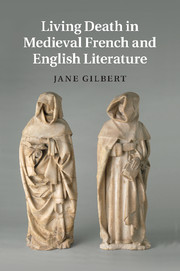Book contents
- Frontmatter
- Contents
- Acknowledgements
- Note on translations
- Introduction: living death
- 1 Roland and the second death
- 2 The knight as Thing: courtly love in the non-cyclic prose Lancelot
- 3 The ubi sunt topos in Middle French: sad stories of the death of kings
- 4 Ceci n'est pas une marguerite: anamorphosis in Pearl
- 5 Becoming woman in Chaucer: on ne naît pas femme, on le devient en mourant
- Conclusion: living dead or dead-in-life?
- Notes
- Bibliography
- Index
- Cambridge Studies in Medieval Literature
Conclusion: living dead or dead-in-life?
Published online by Cambridge University Press: 01 March 2011
- Frontmatter
- Contents
- Acknowledgements
- Note on translations
- Introduction: living death
- 1 Roland and the second death
- 2 The knight as Thing: courtly love in the non-cyclic prose Lancelot
- 3 The ubi sunt topos in Middle French: sad stories of the death of kings
- 4 Ceci n'est pas une marguerite: anamorphosis in Pearl
- 5 Becoming woman in Chaucer: on ne naît pas femme, on le devient en mourant
- Conclusion: living dead or dead-in-life?
- Notes
- Bibliography
- Index
- Cambridge Studies in Medieval Literature
Summary
Previous chapters have, I hope, established both the recurrence of the ‘between two deaths’ in medieval literature and the variety of meanings and uses to which it bends. A question which it has not been possible to pose earlier is: are the formally dead but apparently alive significantly and systematically different from the technically alive but effectively dead? The evidence surveyed here suggests that the former (the Pearl-Maiden, Alceste) are more associated with the idea of demand or obligation which it is the living addressee's duty to fulfil, the latter (Roland, Galehot) with that of sacrifice or willingness to die for a person or cause, thus creating an obligation. However, these categories are not stable. Whereas the Pearl-Maiden bases the authority for her advice to the Jeweller on Christ's death for humankind, Galehot's death for Lancelot's sake is also a petition to Lancelot, although it remains a question whether the latter's failure to reciprocate frustrates or answers Galehot's desire. Roland's death is not originally a sacrifice for Charlemagne, though the later parts of the assonanced Chansons de Roland and the rhymed redactions in toto make it one retrospectively. Blanche/White's consummated death too is rewritten as a sacrifice that she and her mourner make, albeit involuntary on her part and painful on his, for the benefit of surviving members and future generations of their House. This interpretation extracts her from the entre-deux-morts and lays her to rest.
- Type
- Chapter
- Information
- Living Death in Medieval French and English Literature , pp. 215 - 221Publisher: Cambridge University PressPrint publication year: 2011



